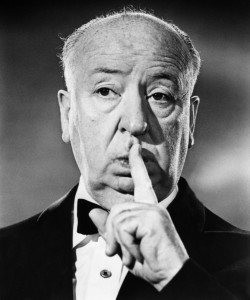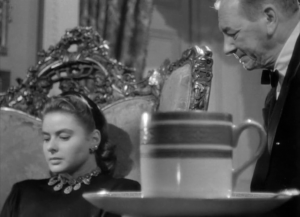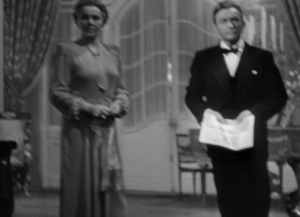 Hitchcock Week: Part Three of Five
Hitchcock Week: Part Three of Five
This week the Madison Film Forum will present reflections on the next five films in the UW Cinematheque’s Hitchcock Masterworks series. These are not intended as reviews for readers who have not seen the films. We hope they will serve as the start of a conversation with those who have seen the films and will be revisiting them at the UW Cinemathque series, or through the streaming resources linked at the end of the entries.
Below Taylor Hanley revisits Notorious (1946), which will play at the Chazen Museum of Art on Sunday, February 23 at 2:00 pm.
Notorious (1946)
Notorious follows Alicia (Ingrid Bergman) who, after her father is imprisoned, is enlisted by the American Government to spy on her father’s former associates. Before receiving her assignment she falls madly in love with Agent Devlin (Cary Grant) and he seemingly loves her as well. Despite his feelings, Devlin instructs Alicia to infiltrate the head of a Brazilian neo-Nazi group, Alex Sebastion (Claude Raines), putting her in a compromising position—It can only be a matter of time before this volatile man finds out who she really is.
The narration throughout Notorious is unrestricted, meaning the audience is omniscient and knows everything the characters know. The audience follows Alicia and Devlin as they plan to gain the trust of Alex by baiting him to fall in love with and marry Alicia. Then we follow Alex as he learns the truth about his wife. The audience remains on top of the knowledge hierarchy and this creates suspense when Alicia becomes the ignorant one. As she continues to believe that she has fooled Alex and is unaware that he is slowly killing her, the audience squirms in their seats with each cup of poisoned coffee that Alicia drinks. The film’s tension builds slowly until a single point where the suspense exceedingly intensifies—the point where Alicia realizes that her husband knows that she is a government agent.
Alicia discovers Alex’s murderous plot during the climax of the film. The scene starts with an establishing shot with Alicia sinking into an arm chair as Alex and his mother face her, the three of them forming a triangle. Another man, Dr. Anderson, stands behind Alicia and leans over her as he initiates a conversation regarding her sickly appearance. We cut to a closer view of Alex’s mother pouring a cup of coffee and the shot continues to decrease in scale as the camera draws us closer to the single cup. We then follow Alex’s mother, viewing a close-up of the cup in her hand, as she delivers it to Alicia.
 Despite Alicia’s sickly appearance, Alex discourages the idea of a doctor. The audience, aware of Alex’s ulterior motive, can easily read through his sly manipulation. Alicia remains mostly unsuspecting, only seeming a bit suspicious about suggestions that she take a vacation. They discuss what is best for Alicia: Dr. Anderson offers to take her to the mountains, the mother asks her to come away to sea with her. In many shots during the conversation, the coffee cup looms unnaturally large in the foreground, but Alicia’s face remains in focus in the background. The cup is gigantic, appearing larger that Alicia’s head. The cup is overpowering her—at least the poison within the cup is.
Despite Alicia’s sickly appearance, Alex discourages the idea of a doctor. The audience, aware of Alex’s ulterior motive, can easily read through his sly manipulation. Alicia remains mostly unsuspecting, only seeming a bit suspicious about suggestions that she take a vacation. They discuss what is best for Alicia: Dr. Anderson offers to take her to the mountains, the mother asks her to come away to sea with her. In many shots during the conversation, the coffee cup looms unnaturally large in the foreground, but Alicia’s face remains in focus in the background. The cup is gigantic, appearing larger that Alicia’s head. The cup is overpowering her—at least the poison within the cup is.
When Dr. Anderson accidentally picks up Alicia’s coffee instead of his own, Alex and his mother jump out of their seats to stop him. Their overreaction alarms Alicia. She immediately realizes that why she is feeling sick—her husband and his mother have been poisoning her. Though this is never stated, like it was never explicitly said that the coffee is the vehicle for the poison, the concentration on the coffee and here on Alicia’s expression makes the implicit obvious: Alicia knows that Alex found out she is a spy and is now trying to kill her.
 The audience then adopts Alicia’s perspective and identifies closely with her heightened emotions. This creates an immediate thrill, feeling and seeing exactly what Alicia is, as the suspense builds with her panic. Exposing the audience to a character’s subjectivity is a trend commonly utilized in Hitchcock films. This trend does not present the objective reality, buta warped perception that illustrates the inner psychology of a character. Here we see Alicia’s emotion-driven illusions caused by the shock and an accumulation of poison. It is dream-like and similar to the scene in Vertigo where we experience James Stewart’s hypnotizing nightmare. Here in Notorious, the film cuts between close-ups of Alicia’s sweating face and shots of distorted figures of Alex and his mother. To her, they have become dark, muffled-voiced, figuresthat hold more resemblance to monsters than to human beings. She slowly stammers to the door, wanting to escape the immediate nightmare but as she turns, she sees that their shadows are caste onto the exit. Their shadows frame the two as one single unit, the same height and size and morphed into one being. Alex and his mother together create an evil presence.
The audience then adopts Alicia’s perspective and identifies closely with her heightened emotions. This creates an immediate thrill, feeling and seeing exactly what Alicia is, as the suspense builds with her panic. Exposing the audience to a character’s subjectivity is a trend commonly utilized in Hitchcock films. This trend does not present the objective reality, buta warped perception that illustrates the inner psychology of a character. Here we see Alicia’s emotion-driven illusions caused by the shock and an accumulation of poison. It is dream-like and similar to the scene in Vertigo where we experience James Stewart’s hypnotizing nightmare. Here in Notorious, the film cuts between close-ups of Alicia’s sweating face and shots of distorted figures of Alex and his mother. To her, they have become dark, muffled-voiced, figuresthat hold more resemblance to monsters than to human beings. She slowly stammers to the door, wanting to escape the immediate nightmare but as she turns, she sees that their shadows are caste onto the exit. Their shadows frame the two as one single unit, the same height and size and morphed into one being. Alex and his mother together create an evil presence.
The music builds in volume and pace with the intensity of the scene. The shots become shorter, the cutting accelerates and the strange-nature enhances. When Alicia finally pushes through the shadows and exits the room, the music comes to a sudden stop. The scene cuts to an extreme long shot that captures Alicia as she collapses to the ground. She has fallen under the control of Alex and his mother. If Alicia would have made this discovery earlier she would have had the strength to leave, but discovering it any later would have been too late. She becomes a victim unable to defend herself. Up until this scene Alicia has held at least some control over the situation, but now all hope seems lost. This exciting scene leaves the audience in exhilarated suspense, hoping that somehow Alicia will escape Alex and his mother’s deadly grip.
Curiously, Notorious is not currently streaming on any instant view services. But in addition to the screening at the UW Cinematheque Hitchcock Masterworks series, you can place the Notorious DVD on hold at the Madison Public Library.